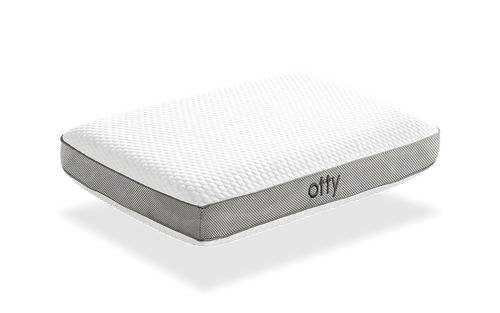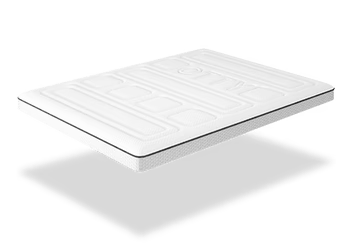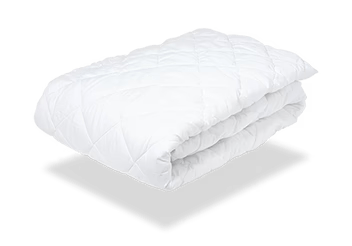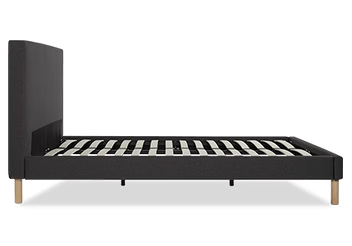Bamboo pillows are great for a comfortable sleep and improved overall sleep hygiene.
They're hypoallergenic, help with spinal alignment and help keep you cool.
If you're considering buying a bamboo pillow, our guide gives you all the information you need to make an informed decision - what they are, why they're so good, and how to find the right bamboo pillow
Table of contents
What are Bamboo Pillows?
Bamboo pillows are made with bamboo-derived materials, typically in the outer cover, combined with a shredded memory foam or other supportive filling.
The bamboo fabric is made from bamboo fibres that are processed into a soft, breathable textile known for its moisture-wicking and temperature-regulating properties.
Bamboo pillows have hypoallergenic qualities, are resistant to dust mites, and conform to the shape of the head and neck to provide personalised support.
Some pillows, like our Bamboo Memory Foam Pillow actually use bamboo & charcoal infused memory foam, to absorb odour, wick away moisture, and provide a myriad of other health benefits.
Bamboo Pillows Are Hypoallergenic
Bamboo pillows have hypoallergenic properties, a feature that sets them apart from other pillows.
The natural fibres of the bamboo plant are resistant to dust mites and other allergens, making them an excellent choice for those with allergies or sensitivities.
Bamboo pillows also absorb odour, contributing to a fresher and cleaner sleeping environment. This is particularly beneficial for individuals who may suffer from night sweats or hot flashes, as the bamboo fibres work to wick away moisture and maintain a comfortable sleep temperature.
In addition, the breathability of bamboo pillows enhances air circulation, reducing the risk of mould and mildew growth. This further bolsters their hypoallergenic credentials, providing a safe and healthy option for a good night's sleep.
Bamboo Pillows Support Spinal Alignment
Bamboo pillows help promote proper spinal alignment.
The filling of bamboo pillows is designed to provide optimal support to your neck and spine, helping to maintain proper alignment while you sleep.
This filling molds to the shape of your head, neck, and shoulders, providing customised support that helps keep the spine in a neutral, aligned position during sleep.
The shredded foam allows for better airflow and adjustability. You can fluff or compress the pillow to suit your preferred sleeping posture. Whether you sleep on your back, side, or stomach, a well-adjusted bamboo pillow helps reduce pressure points and maintain proper curvature of the spine, which can alleviate neck and back pain over time.
This can be particularly beneficial for those suffering from chronic back pain.
Do Bamboo Pillows Help With Neck Pain?
The unique fibre elasticity of bamboo pillows provides the right amount of support to alleviate neck pain. They contour to the shape of your neck, ensuring optimal spinal alignment, which is crucial for a pain-free sleep.
The Benefits of Bamboo Pillows
Improved Spinal Alignment
Bamboo pillows often feature a shredded memory foam filling that adapts to the unique contours of your head, neck, and shoulders.
This contouring ability helps maintain the natural curve of your cervical spine, reducing strain and promoting proper posture throughout the night. When your spine is correctly aligned during sleep, it alleviates pressure on joints and muscles, potentially decreasing the risk of chronic neck, shoulder, and back pain.
Unlike traditional pillows that flatten or provide uneven support, bamboo pillows can be adjusted by adding or removing filling, allowing for a more personalised fit whether you're a back, side, or stomach sleeper.

Hypoallergenic Properties
The outer cover of bamboo pillows is typically made from bamboo-derived rayon or viscose, which is naturally hypoallergenic. This material resists the accumulation of allergens such as dust mites, mould, mildew, and bacteria, which are common triggers for allergies and respiratory issues.
People with asthma or sensitive skin may especially benefit from bamboo pillows because they reduce the likelihood of waking up with congestion, itchy eyes, or skin irritation. In addition, the antimicrobial qualities of bamboo fibers help keep the pillow fresher for longer periods, contributing to better overall sleep hygiene.

Breathability and Temperature Regulation
One of the standout features of bamboo fabric is its excellent breathability. The porous structure of bamboo fibres allows air to circulate more freely, which helps dissipate body heat and moisture. This results in a cooler sleeping surface compared to traditional cotton or polyester pillows, making bamboo pillows ideal for people who tend to sleep hot or experience night sweats.
The moisture-wicking properties also draw sweat away from the skin, keeping you dry and comfortable throughout the night. This thermoregulation can improve sleep quality by minimizing disruptions caused by overheating or dampness.

Eco-Friendly and Chemical-Free
Bamboo is a highly sustainable resource that grows rapidly without the need for pesticides or fertilisers. This makes bamboo-based products, including pillows, more environmentally friendly than those made from synthetic or chemically-intensive materials.
For health-conscious consumers, this means reduced exposure to off-gassing and toxic compounds that can irritate the skin, lungs, or endocrine system. Choosing a bamboo pillow supports not only your personal health but also a more sustainable and responsible manufacturing process.

What Is The Lifespan Of A Bamboo Pillow?
A bamboo pillow typically lasts between 2 to 3 years, though its lifespan can vary based on the quality of materials and how well it’s maintained. High-density shredded memory foam and a durable bamboo cover can help extend its usability, especially when the pillow is regularly fluffed, aired out, and kept clean. Proper care prevents the fill from clumping and the cover from wearing out prematurely.
Over time, even with good maintenance, the pillow may lose its supportive structure or develop odoUrs and stains that are difficult to remove. When it no longer provides adequate neck or spinal support, or starts causing discomfort, it's a good indication that it's time to replace it.
How To Maintain Your Bamboo Pillow
Wash the Bamboo Cover Regularly
Remove the outer bamboo cover (usually zippered).
Machine wash in cold water on a gentle cycle.
Air dry or tumble dry on low heat to avoid shrinking.
✅ Do this every 1–2 weeks to keep it clean and allergen-free.
Fluff the Pillow
Fluff the pillow by hand or toss it in the dryer on air-only or low heat for 10–20 minutes.
This redistributes the fill and maintains loft and support.
✅ Do this weekly or as needed to prevent the foam from compacting.
Air Out Periodically
Place the pillow in a well-ventilated area or outside (in the shade) for a few hours every couple of months.
Helps eliminate odors and excess moisture.
✅ Avoid direct sunlight, which can break down materials over time.
Spot Clean the Inner Fill (If Necessary)
Check if the inner memory foam is not washable (often true).
For small spills, use a mild detergent and damp cloth to spot clean.
Air dry completely before using again.
✅ Never soak the inner foam unless the care label explicitly allows it.
Store Properly When Not in Use
Keep it in a dry, breathable storage bag, not plastic.
Store in a cool, dry place to avoid mildew or damage.
Summary and Key Takeaways
Bamboo pillows offer firm support, enhance sleep quality, and provide a host of health benefits.
Their unique properties make them an excellent choice for those with sensitive skin or allergies.
They support spinal alignment and help to can alleviate neck pain
Bamboo pillows are a sustainable and eco-friendly option, offering an alternative to traditional memory foam or organic pillows.
While the initial cost may be higher than other pillow types, the long-term benefits of bamboo pillows, including their durability and the potential for improved overall health, make them a worthwhile investment.










